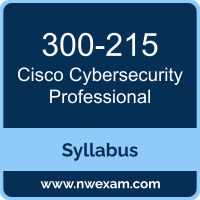 A great way to start the Cisco Certified Specialist - Cybersecurity Forensic Analysis and Incident Response (CBRFIR) preparation is to begin by properly appreciating the role that syllabus and study guide play in the Cisco 300-215 certification exam. This study guide is an instrument to get you on the same page with Cisco and understand the nature of the Cisco Cybersecurity Professional exam.
A great way to start the Cisco Certified Specialist - Cybersecurity Forensic Analysis and Incident Response (CBRFIR) preparation is to begin by properly appreciating the role that syllabus and study guide play in the Cisco 300-215 certification exam. This study guide is an instrument to get you on the same page with Cisco and understand the nature of the Cisco Cybersecurity Professional exam.
Our team of experts has composed this Cisco 300-215 exam preparation guide to provide the overview about Conducting Forensic Analysis and Incident Response Using Cisco Technologies for Cybersecurity exam, study material, sample questions, practice exam and ways to interpret the exam objectives to help you assess your readiness for the Cisco CBRFIR exam by identifying prerequisite areas of knowledge. We recommend you to refer the simulation questions and practice test listed in this guide to determine what type of questions will be asked and the level of difficulty that could be tested in the Cisco Cybersecurity Professional certification exam.
Cisco 300-215 Exam Overview:
| Exam Name | Conducting Forensic Analysis and Incident Response Using Cisco Technologies for Cybersecurity |
| Exam Number | 300-215 CBRFIR |
| Exam Price | $300 USD |
| Duration | 90 minutes |
| Number of Questions | 55-65 |
| Passing Score | Variable (750-850 / 1000 Approx.) |
| Recommended Training |
Conducting Forensic Analysis and Incident Response Using Cisco Technologies for Cybersecurity | CBRFIR Conducting Forensic Analysis and Incident Response Using Cisco Technologies for Cybersecurity (CBRFIR) v1.0 |
| Exam Registration | PEARSON VUE |
| Sample Questions | Cisco 300-215 Sample Questions |
| Practice Exam | Cisco Certified Specialist - Cybersecurity Forensic Analysis and Incident Response Practice Test |
Cisco 300-215 Exam Topics:
| Section | Weight | Objectives |
|---|---|---|
| Fundamentals | 20% |
- Analyze the components needed for a root cause analysis report - Describe the process of performing forensics analysis of infrastructure network devices - Describe antiforensic tactics, techniques, and procedures - Recognize encoding and obfuscation techniques such as base 64, hex encoding, polymorphic and metamorphic coding - Describe the use and characteristics of YARA rules (basics) for malware identification, classification, and documentation - Describe the role of:
- Describe the issues related to gathering evidence from virtualized environments (major cloud vendors) |
| Forensics Techniques | 20% |
- Recognize the methods identified in the MITRE attack framework to perform fileless malware analysis - Determine the files needed and their location on the host - Evaluate SIEM, malware analysis, and other tools output(s) to identify IOC on a host
- Determine the type of code based on a provided snippet |
| Incident Response Techniques | 30% |
- Interpret alert logs such as SIEM, IDS/IPS and syslogs - Determine data to correlate based on incident type (host-based and network-based activities) - Determine attack vectors or attack surface and recommend mitigation - Recommend actions based on post-incident analysis - Recommend mitigation techniques for evaluated alerts from firewalls, SIEM, SOAR platforms, intrusion prevention systems (IPS), data analysis tools such as Cisco Umbrella, Cisco Secure Network Analytics, and Cisco XDR), and other systems to respond to cyber incidents - Recommend response to 0 day exploitations such as risk assessment and exploitation prediction, SIEM data collection and processing in AI-based predictive vulnerability management - Recommend a response based on intelligence artifacts - Recommend the Cisco security solution for detection and prevention - Interpret threat intelligence feeds to determine IOCs and IOAs from internal and external sources - Evaluate artifacts from threat intelligence to determine the threat actor profile - Describe capabilities of Cisco security solutions related to threat intelligence such as Cisco Umbrella, Firepower, Cisco Secure Endpoint, and Cisco Secure Network Analytics |
| Forensics Processes | 15% |
- Describe antiforensic techniques such as Geo location, obfuscation, evading detection, data destruction, and hindering forensics - Analyze logs from modern web applications and servers (Apache and NGINX) - Analyze network traffic associated with malicious activities using network monitoring tools such as NetFlow and display filtering in Wireshark - Recommend next step(s) in the process of evaluating files based on distinguished characteristics of files - Interpret binaries using objdump and other CLI tools such as Linux, Python, and Bash |
| Incident Response Processes | 15% |
- Describe the goals of incident response - Evaluate elements required in an incident response playbook - Evaluate the relevant components from the ThreatGrid report - Recommend next step(s) in the process of evaluating files from endpoints and performing ad-hoc scans - Analyze threat intelligence provided in different formats such as STIX and TAXII |
Cisco CBRFIR Exam Description:
Conducting Forensic Analysis and Incident Response Using Cisco Technologies for Cybersecurity v1.2 (CBRFIR 300-215) is a 90-minute exam that is associated with the CCNP Cybersecurity Certification. This exam certifies a candidate's knowledge of forensic analysis and incident response fundamentals, techniques, and processes. The course Conducting Forensic Analysis and Incident Response Using Cisco Technologies for Cybersecurity helps candidates to prepare for this exam.
